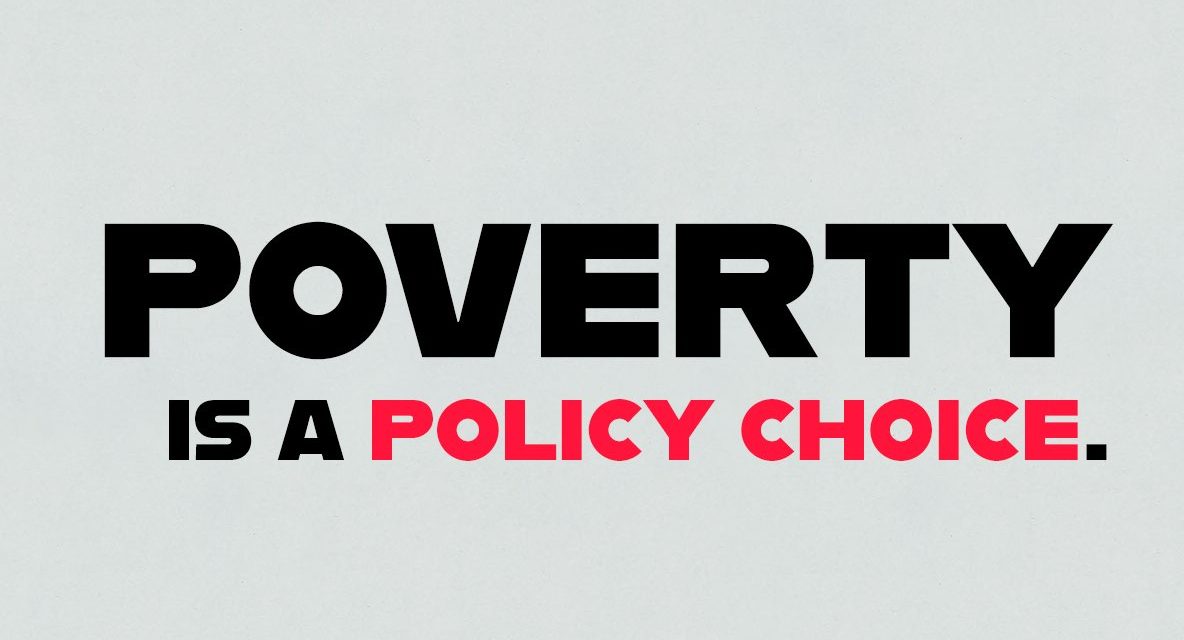Poverty is a choice.
Not the cliched “pull yourself up by your bootstraps” attitude that treats every Memphian as having the same kinds of opportunities that provides them with the boots to pull on.
Rather, poverty is a choice made by our community for 142,000 of our men, women, and children. Despite decades of rhetoric about solving the problem of poverty that dogs Memphis, the number of men, women, and children trapped in a system designed to hold them is frustratingly consistent. The overall Memphis poverty rate is 24.2% but the poverty rate for African Americans is higher by about 17% percent.
This does not result from a person’s bad decisions and bad luck. Rather, the intractable poverty in our community is, simply put, the result of a system designed to produce it.
Harsh Realities
It should not be surprising. A favorite epigram is that “every system is perfectly designed to get the results it gets.” It then follows that “if we keep doing what we’ve been doing, we’ll keep getting what we’ve been getting.”
And that is precisely what we’ve done here, and without changing the system, poverty persists and despite the decades-long talk about new programs and new plans, the underlying structural, philosophical, and economical foundations of the problem remain.
The problem is stark. Among cities with more than 500,000 people, Memphis is #5 in highest poverty rate and #4 in cities with the highest child poverty rate. As we entered the 21st century 23 years ago, the overall poverty rate was 16% and Black poverty was 25.6% and today, it is respectively 24.2% overall and about 26.5%.
Roughly one in three children in Memphis live in poverty. Children born in a low-income family in Memphis have only a four percent chance of becoming a high-income adult, and those are the worst odds for any major city in the continental United States.
Stuck In Time
Put directly, despite decades of talk about ending poverty, there is little to brag about.
In fact, there are harsher data points that underscore that the system is tilted against Black Memphians. At the time of the 1968 murder of Dr. Martin Luther King Jr., only 9% of African Americans in Memphis had high school degrees but that number increased ninefold by 2000. In the same time period, the percentage of African Americans earning bachelor’s degrees went from 4% to 20%.
In the era when Dr. King was killed, African American leaders were told that more education was the key to earning more and capturing the American Dream. And yet, after the dramatic rise in high school diplomas and bachelor’s degrees that outstripped the trajectory of Whites with the same degrees, it seemed apparent to many African Americans in Memphis that someone had their thumb on the scales.
Here’s why: in 1970, the median household income for Whites was twice that of African Americans. Despite the dramatic increase in educational attainment, today, in Shelby County, it remains the same.
Median household income in Shelby County for African Americans is $41,543. Median household income for Whites is $82,594, according to the indispensable 2022 Memphis Poverty Fact Sheet by Dr. Elena Delavega and Dr. Gregory M. Blumenthal.
Unleashing Potential
It would seem that striving to unleash this untapped economic potential to drive up the Memphis MSA GDP by more than $25 billion would be enough for everyone in this community to sign on to a determined campaign to reduce poverty and increase the incomes of African Americans.
But instead, the system continues to produce the precise results it’s designed to produce. There’s no other way to make sense of it.
I repeat questions from a previous post that indicates how we are stuck in time:
* Can you remember a time when a political or business leader discussed how Memphis’ African American majority is a competitive advantage? How can Memphis be the model of success for other diverse cities?
* Can you remember when a political or business leader advanced a vision of Memphis as a hub of African American talent? Atlanta became an economic dynamo by setting the goal of becoming a national hub of Black talent. Why can’t Memphis do the same?
* Can you remember when a political or business leader said that closing the racial income gap – which would create more than $25 billion in new GDP for Shelby County – is the #1 economic development priority for our community?
* Can you remember when a comprehensive investment agenda targeting the levers of progress for Black Memphians was launched citywide for a long enough time to increase African American wealth to reduce poverty?
At this point, the obvious answers to the questions are indications that the system will continue to produce the same results that it has in past decades.
Forgetting to Transition to Future
The Memphis Jobs Conference was launched in 1981 because Memphis was lagging behind its regional rivals and economic signs for the future were not good. To jump start the economy, the Jobs Conference set tourism, logistics and distribution (FedEx had begun operations in Memphis eight years earlier), and agricultural research as top priorities.
It is impossible to miss the conclusion that the priorities set in the meetings reflected the vested interests of companies benefitting most from low-wage, low-income workers.
June 1, 2017: The injustice of a Memphis economy built on low-wage jobs
The then faltering Memphis economy was boosted by the Jobs Conference and the priority sectors boomed, relying heavily on low wage-low skills jobs. Cynically, it can be said that people of means and influence, in their own self-interest, relegated their fellow Memphians to continue to work in low-income jobs.
As economist David Ciscel said on this blog, the problem with the Jobs Conference priorities was that the community got stuck in that agenda and made no effort to develop a plan that transitioned to better-paying knowledge economy jobs.
Without that transition strategy, tens of thousands of Memphians were stuck along with the economy in jobs that placed a premium on cheapness – keeping costs and taxes as low as possible, paying as little in wages as possible, and placing little value in training workers.
It’s easy to draw a straight line from Memphis’ commodities history with its emphasis on cheapness and the attitude that followed the Jobs Conference. That attitude resulted in city and county governments giving birth to their PILOT (payment-in-lieu-of taxes) program to reward companies and real estate developers with generous tax breaks.
Leaning to Higher Income People
At the time the PILOT program was created, the employees of some companies receiving tax breaks qualified for food stamps and publicly subsidized health care. Recently, Memphis and Shelby County Economic Development Economic Engine (EDGE) amended its criteria to require that a company must pay its employees $15 an hour in order to receive a PILOT. Until that change a few months, companies paying $13 an hour could qualify for a tax break.
Somehow, in the public mind, $15 an hour has become the definition of a living wage; however, the MIT Living Wage Calculator or the United Way A.L.I.C.E. Index demonstrate that $15 is inadequate. Meanwhile, companies and organizations pat themselves on the back for paying $15 an hour although it does not reduce poverty or boost the economy.
That’s why the recent sparring between the Arlington School District and the Germantown School District was so telling – and disturbing – about our community’s point of view. The school district for Germantown, which has some of the highest median incomes in Tennessee at $132,949, was irate because it was paying its janitorial workers $12 an hour and Arlington began to pay its workers $15 an hour.
“I’m a little irritated that Arlington is just apparently throwing money around, and we’re having to react,” said Germantown school board member Brian Curry. “They’ve caused us to budget money that could be going elsewhere.”
His comment said volumes about the attitude toward low-wage earners in our community; they exist to be exploited. It’s no wonder that 42% of Black workers earn less than $15 an hour. Germantown’s school budget is $87 million a year.
May 11, 2022: Memphis potential is about Black Memphians reaching theirs
Mr. Curry’s comment also speaks to the geographic inequality that propels the poverty problem in our community and the public policies that do nothing to solve it.
The gap between rich and poor areas, between thriving, wealthier eastern urban centers like Germantown and urban core neighborhoods with high poverty, creates a political imbalance that result in conservative legislators from those well-to-do areas injecting their personal philosophies into laws that stifle local self-determination, that bind local governments to tax sources regressive at their cores, that block living wage resolutions, that block federal funding that could benefit Memphis neighborhoods, that cut the threads of the social safety net, and more, all while creating tax perks and new tax benefits for higher income citizens.
The legislative preference for people with higher incomes is built into Tennessee’s tax structure, one of the most regressive in the country. It means that the less someone earns, the greater the percentage that the person pays in taxes. For example, someone earning $25,000 a year has a tax burden of 18%, but someone earning $150,000 has a tax burden of 5%. It is a textbook case of regressivity and also a textbook example of how the system is designed to punish those who need the support the most.
Geographic inequality also surfaces in City of Memphis policies that put lower taxes as a top priority ahead of lower poverty rates. There never seems to be enough money to invest in low-income Memphis workers and Memphians who live in poverty.
Memphians are told that the city does not have enough money to fully fund public transit, it doesn’t have enough money to reverse the disinvestment of low-income areas, it doesn’t have enough money to open libraries and community centers longer, it doesn’t have enough money to combat economic segregation. It doesn’t have enough money to invest in more affordable housing to combat the swamp of predatory rental companies.
And yet, while local government never seems to have the money for these purposes, it has no problem waiving an estimated $2.6 billion in taxes since the PILOT program was established in about 1987.
A Failed System
Because of these prevailing politics, Memphis has failed to create a geography of opportunity and shared prosperity. And that’s despite the fact that the Memphis property tax rate is the lowest it has been in 32 years – by 48 cents; however, rather than invest in intervention services and direct services, the Memphis mayor – and Shelby County Mayor Lee Harris too – emphasizes saving money that most benefits the wealthier people in our community.
And the cycle continues from a cruelly designed system and the Greater Memphis Chamber confirms it.
The Chamber ranks the Memphis region against Nashville, Louisville, Kansas City, Indianapolis, St. Louis, Birmingham, Milwaukee, Oklahoma City, and New Orleans, and in measurements particularly relevant to fighting poverty, the rankings shine a harsh light on the failure of our system.
Here are the rankings:
Shared Prosperity – #9 of 10
Inclusive Economic Growth – #9
Job Accessibility – #10
Economic Stability – #10
Per Capita GDP – #10
Bachelor’s Degrees – #10
Median Household Income – #9
Systemic Crisis
Brookings reported today that the Memphis metro is #5 in metros with Black-owned employer businesses. However, it added that there are 1,158 Black businesses, accounting for 6.4% of employer businesses, and if Black businesses accounted for 48.6% of employer firms (equivalent to the Black population), there would be 15,851 more Black businesses. Also, Black businesses create an average of 8 jobs per firm, compared to 30 for all businesses. If the average employees per Black business reached parity, it would create approximately 25,473 new jobs.
To underscore the crisis that we ignore at our peril, consider that the Tennessee Commission on Children and Youth released the Child Well-Being Profiles earlier this month. Shelby County ranks #92 for economic well-being; in education, the county is #91; and in health, Shelby County is #93. There are 95 counties in Tennessee.
If we can stand by and watch children in poverty deal with the tough realities of their daily lives, it’s little wonder there is so little movement to actually marshal a community army to reduce the poverty rate for their parents.
Yes, poverty is a choice. It’s just not a choice made by those trapped by it. It’s a choice made by a system perfectly designed to keep one out of four Memphians in it.
**
Join us at the Smart City Memphis Facebook page and on Instagram for daily articles, reports, and commentaries that are relevant to Memphis.






As usual, a very good article leading up to the Poverty By America lecture next week over at Rhodes. I think it is important to remember the structural basis of poverty in the United States — particularly relative to the service sector of the economy. But Memphians just don’t talk about poverty. There are many non-profits that spend effort, resources, and time recusing people trapped in poverty. Many individuals are really helped by these organizations — lead by the two giant non-profits, MIFA and the Food Bank. But for each individual who is helped out of poverty by these very helpful organization, a new person falls into poverty. That’s what structural poverty is all about — until all jobs pay a living wage, until all jobs are somewhat stable, until all jobs have that middleclass bundle of benefits, and until we recognize that it doesn’t take $15 million per year to run a successful corporation, we will not see changes in poverty in Memphis or the USA.